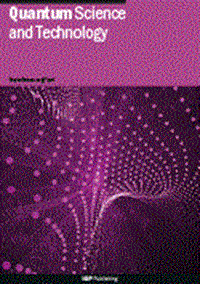利用横向场振幅和相位控制实现双量子位量子电池的快速充电
IF 5
2区 物理与天体物理
Q1 PHYSICS, MULTIDISCIPLINARY
引用次数: 0
摘要
在常规的核磁共振框架下,我们考虑了一个由一对量子比特与伊辛相互作用耦合组成的量子电池(QB),其中纵向施加的场是恒定的,控制系统的时变变量是横向场的振幅和相位,并使用最优控制来推导快速充电协议。我们研究了伊辛耦合比纵向场强和弱的两种情况。在第一种情况下,系统的最低能量状态为自旋下降状态,最优充电协议规定横向场振幅恒定并等于其最大允值,而电池充满电的最小时间随着该最大界的增加趋于零。在第二种情况下,当最低能态为最大纠缠贝尔态时,最优充电协议包含一个时间间隔,其中横向场振幅为零,其相位无关紧要,对应于奇异控制。在这种情况下,QB可以用更高水平的存储能量充电,而充满电的最小时间趋于与逆伊辛相互作用成正比的非零极限,因为控制振幅的最大界增加。我们直观和定量地分析了这两种情况的不同行为,并利用系统的动态李代数解释了第二种情况下最优脉冲序列中奇异弧的存在。所发现的QB参数、存储能量和最小完全充电时间之间的相互作用,为根据运行约束优化器件的性能提供了很大的灵活性。关于qb设计的宝贵见解有望在现代量子科学和技术中得到直接应用,而我们的目标是将所提出的方法扩展到更大的自旋链。本文章由计算机程序翻译,如有差异,请以英文原文为准。
Rapid charging of a two-qubit quantum battery by transverse field amplitude and phase control
We consider a quantum battery (QB) composed of a pair of qubits coupled with an Ising interaction in the usual NMR framework, where the longitudinal applied field is constant and the time-dependent variables controlling the system are the amplitude and phase of the transverse field, and use optimal control to derive fast charging protocols. We study both the cases where the Ising coupling is weaker and stronger than the longitudinal field. In the first case, where the lowest-energy state of the system is the spin-down state, the optimal charging protocol stipulates the transverse field amplitude to be constant and equal to its maximum allowed value, while the minimum time for full charging of the battery tends to zero as this maximum bound increases. In the second case, where the lowest-energy state is a maximally entangled Bell state, the optimal charging protocol includes a time interval where the transverse field amplitude is zero and its phase is immaterial, corresponding to singular control. In this case, the QB can be charged with higher levels of stored energy, while the minimum time for full charging tends to a nonzero limit proportional to the inverse Ising interaction, as the maximum bound of the control amplitude increases. We analyze intuitively and quantitatively the distinct behavior of the two cases and additionally use the dynamical Lie algebra of the system to elucidate the presence of a singular arc in the optimal pulse-sequence in the second case. The discovered interplay between the QB parameters, the stored energy and the minimum time for full charging, provides great flexibility for optimizing the performance of the device according to the operating constraints. The valuable insights gained regarding the design of QBs is expected to find immediate applications in modern quantum science and technology, while we aim to extend the proposed methods to larger spin chains.
求助全文
通过发布文献求助,成功后即可免费获取论文全文。
去求助
来源期刊

Quantum Science and Technology
Materials Science-Materials Science (miscellaneous)
CiteScore
11.20
自引率
3.00%
发文量
133
期刊介绍:
Driven by advances in technology and experimental capability, the last decade has seen the emergence of quantum technology: a new praxis for controlling the quantum world. It is now possible to engineer complex, multi-component systems that merge the once distinct fields of quantum optics and condensed matter physics.
Quantum Science and Technology is a new multidisciplinary, electronic-only journal, devoted to publishing research of the highest quality and impact covering theoretical and experimental advances in the fundamental science and application of all quantum-enabled technologies.
 求助内容:
求助内容: 应助结果提醒方式:
应助结果提醒方式:


